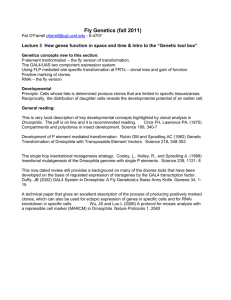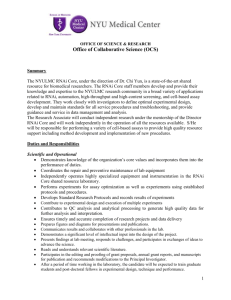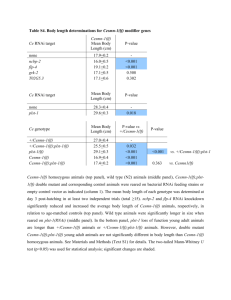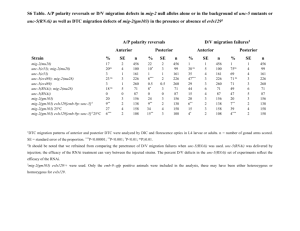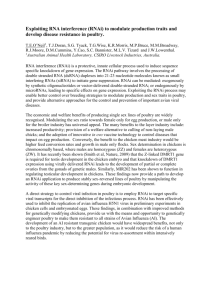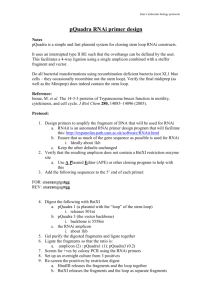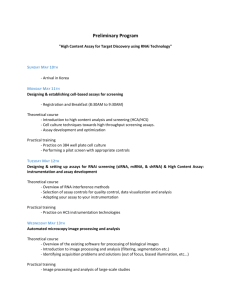Complementation of lethal mutations
advertisement
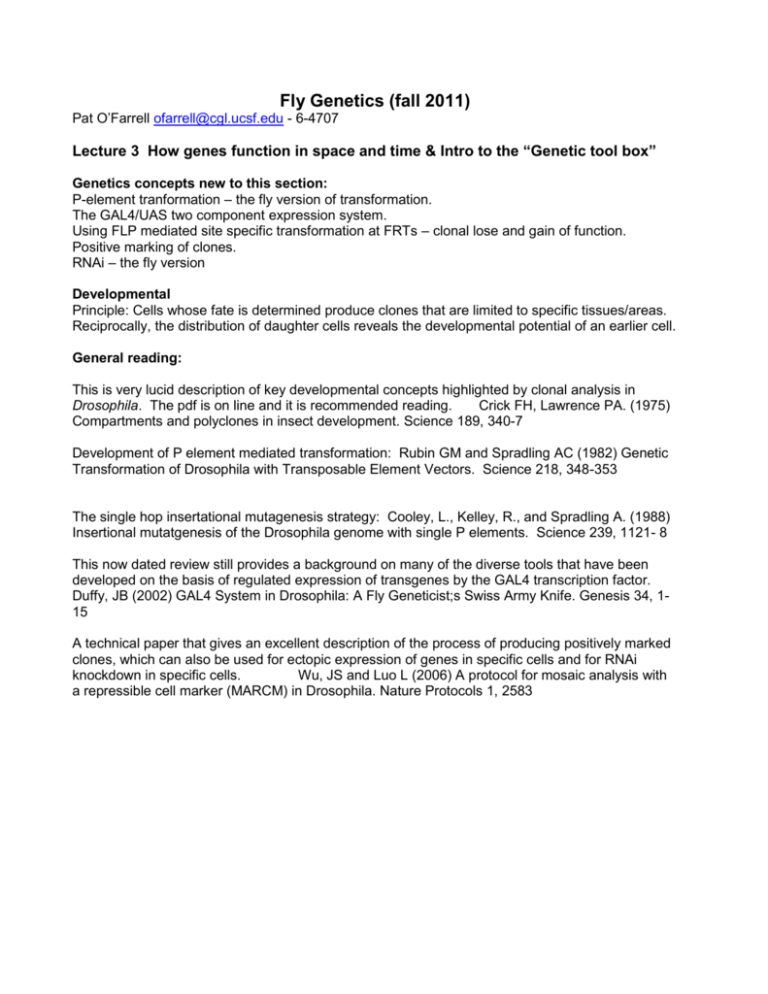
Fly Genetics (fall 2011) Pat O’Farrell ofarrell@cgl.ucsf.edu - 6-4707 Lecture 3 How genes function in space and time & Intro to the “Genetic tool box” Genetics concepts new to this section: P-element tranformation – the fly version of transformation. The GAL4/UAS two component expression system. Using FLP mediated site specific transformation at FRTs – clonal lose and gain of function. Positive marking of clones. RNAi – the fly version Developmental Principle: Cells whose fate is determined produce clones that are limited to specific tissues/areas. Reciprocally, the distribution of daughter cells reveals the developmental potential of an earlier cell. General reading: This is very lucid description of key developmental concepts highlighted by clonal analysis in Drosophila. The pdf is on line and it is recommended reading. Crick FH, Lawrence PA. (1975) Compartments and polyclones in insect development. Science 189, 340-7 Development of P element mediated transformation: Rubin GM and Spradling AC (1982) Genetic Transformation of Drosophila with Transposable Element Vectors. Science 218, 348-353 The single hop insertational mutagenesis strategy: Cooley, L., Kelley, R., and Spradling A. (1988) Insertional mutatgenesis of the Drosophila genome with single P elements. Science 239, 1121- 8 This now dated review still provides a background on many of the diverse tools that have been developed on the basis of regulated expression of transgenes by the GAL4 transcription factor. Duffy, JB (2002) GAL4 System in Drosophila: A Fly Geneticist;s Swiss Army Knife. Genesis 34, 115 A technical paper that gives an excellent description of the process of producing positively marked clones, which can also be used for ectopic expression of genes in specific cells and for RNAi knockdown in specific cells. Wu, JS and Luo L (2006) A protocol for mosaic analysis with a repressible cell marker (MARCM) in Drosophila. Nature Protocols 1, 2583 Hybrid dysgenesis ! Fly from the wild ! X Few progeny The progeny have shriveled gonads and are almost sterile The few F2 progeny sport frequent mutations Dysgenesis is due to Infection by Transposition Element Transposition elements: There are three modes of transposition, conservative (or cut and paste), replicative and retrotransposition. The P element uses cut-and-paste, catalyzed by transposase. Regulation – Repressor of transposase in the eggs of wild flies Repressor – small RNA based but not the type you are used to. Three types: RNAi Micro RNA PIWI RNAs Fly from the lab P element as a Transgenesis Tool Transposase source: Delta 2-3 on III markedwith Kinked (Ki). P element vectors: Cis sites for transposition, marked with a w+ gene, refined cloning expression tools. Insertion of DNA: Transposon is introduced by injection into transposase expressing egg and DNA hops from plasmid into genome. Events are detected by the introduction of the w+. Commercial generation of transgeneics for ~ $200. Mobilizing a P – to mutagenize/trap etc. Cross flies carrying a w+ P element to flies expressing transposase Male progeny with both element and enzyme --- get transposition Cross and recover progeny without the transposase, and with w+ on different chromosome than it started on. P element mutagenesis – a gene knockout collection:. Genes and insertions in 100 kb of genome (see FlyBase) . Enhancer trapping: An enhancer trap marks dentridritic projections of specific sensory cells in the epidermis of the larvae (right). GAL4 System/2 component systems GAL4 Drivers: Enhancer traps that drive GAL4 expression. UAS targets: Genes of interest under the control of a UASGAL4. Added control: GAL80 inhibits GAL4. Removing GAL80 (e.g. by mitotic recombination) allows GAL4 to function only in the cells that lack GAL80 – e.g. in the clone. Using temperature sensitive GAL80, a GAL4 system can be held repressed at low temperature until a desired time when a temp upshift inactivates the inhibitor and turns on transcription. FLP/FRT System The yeast FLP recombinase acts at FRT sites to induce recombination. This activity has been put to great use in flies. FLP based mitotic recombination to produce clones: FLP can be used in various ways: Flip out cassette – Clonal expression FLP is also useful in different strategy in which one induces clonal expression and/or loss of expression of transgene. A Little about the fly eye . Making the eye homozygous for one chromosome arm http://www.BruinFly.ucla.edu/methods.php Also see - Stowers RS, et al. (2002) Axonal transport of mitochondria to synapses depends on milton, a novel Drosophila protein. Neuron. 36(6):1063-7 Positively Marked Clones (MARCM) Recessive markers only mark homozygous cells produced by recombination, but GFP marks both UAS-GFP heterozygous and homozygous cells. Consequently, to mark clones with GFP, investigators used to follow loss of GFP in the homozygous loss clone. It was difficult to follow small clones in a sea of positive signal. GAL80 allows positive emarking. Second two component system (from Quinic acid regulon of Neurospora crasa): Q system (C.J. Potter and L. Luo) Independent TF, repressor and sites Combine with GAL4 to make twin spot MARCM RNAi in flies Long dsRNA Flies works Worms works Cell autonomy autonomous Transitive/* intransitive Amplification Intransitive * Spreads throughout (except nervous system) Transitive Apparently not Amplifies signal Mammals Doesn’t work: induces interferon response that nonspecifically shuts down translation (viral defense strategy) ? ? ? Transitive: Intransitive: Importance: Control. RNAi in cell culture Cell culture RNAi screening in Drosophila cell culture is uniquely simple. Advantages of Drosophila S2 cells: 1. Take up long dsRNA directly from media 2. Robotic PCR from genomic DNA, & symmetric transcription -> dsRNAs to all of the genes. 3. The whole genome can be screened days. 4. Experimental dissection. One, two, three or more dsRNAs can be used to knockout combinations of genes, and film (e.g. cytokinesis defect). Echard, A., Hickson, GRX, Foley, E., and O’Farrell, PH. (2004) Terminal Cytokinesis Events Uncovered after an RNAi Screen. Curr. Biol. 14(18):1685-93 Foldback transgenes http://www.vdrc.at/rnai-library/ Two libraries –1. The GD Library: 2. The second library has inserts (10,714) in a common site. Similar except a new transgenic technology that uses a phage site specific recombinase (phiC31) to insert RNAi constructs at specific docking sites. The benefit is that the context effect on gene expression is removed. Disadvantage – can’t be combined in large numbers because they are allelic. 2 other large libraries of RNAi constructs – one in Boston and one in Kyoto. Boston also provides reagents and technical help for cell based RNAi screens RNAi knockdowns – in space and time Since RNAi transgenes are under the control of UAS, they can be expressed ubiquitously or in any tissue with the appropriate driver and they can be regulated by GAL80ts for temporal control, or by GAL80 in the MARCM system to specifically inactivate the gene in individual marked cells. Using gene dose, and temperature the severity of knockdown can be adjusted. RNAi by injection dsRNA can be injected into the early embryo and maternal RNAs can be eliminated or accumulation of zygotic product blocked – maternally provided proteins are of course immune to this. Triple RNAi of the three mitotic cyclins of Drosophila by dsRNA injection into the anterior (left) pole blocks subsequent mitoses and the domain of action expands with time to halt successive waves of mitosis. McCleland ML and O’Farrell, PH (2008) RNAi of Mitotic Cyclins in Drosophila Uncouples the Nuclear and Centrosome Cycle. Curr Biol. 18(4):245-54 A special heritage http://www.genetics.org/cgi/content/full/160/4/1265 http://www.genetics.org/cgi/content/full/161/1/1 The work of EB Lewis beginning in the 1940’s gave us an extraordinary view of genetic and of development. The scientific community is still trying to catch up with the implications of some of the things he found. I will mention two genetic phenomena that he described because they are especially meaningful to the genetics of regulation. Homeotic mutations: Cause the development of normal structure in the wrong place! (The normal function of a homeotic gene is to direct the expression of the normal structure in its normal place. Homeosis (the transformation of one structure into another) occurs when a homeotic gene is ectopically expressed in a position where it should not be, as in the neomorphic Antp mutant, or indirectly because of the absence of expression of a homeotic gene in its normal domain. Regulatory interactions (repression hierarchy) among the homeotic genes contributes to their normal patterns of expression, and loss of expression of one gene can result in another gene being derepressed in the formally occupied domain.) Lewis studied a cluster of “genes” specifying the differences between segments, the Bithorax Complex. Fig. Phenotypes of bithorax complex mutations. (A) Dorsal view of a wild-type male. The T2 segment produces the single pair of wings as well as almost all of the dorsal thorax. Dorsally, T3 produces only the halteres, small clubshaped organs located posterior to the wings. (B) The famous fourwinged fly, in which T3 is transformed to T2. This male is hemizygous for the triple-mutant combination abx bx3 pbx. The abx pseudoallele has effects similar to bx mutations, but causes a stronger transformation of the very anterior portion of T3. (C) A Cbx male showing transformation of T2 toward T3. Generally, Cbx transforms only the posterior portion of T2, as seen on the right side of this fly. Occasionally, all of T2 is affected, as occurs on the left side. (D) Ventral view of a wild-type female. Each of the thoracic segments produces a pair of legs. (E) Ventral view of a bxd hemizygous female. An extra pair of legs is present as a result of the transformation of A1 toward T3. (F) Ventral view of an Hab female. The third pair of legs is lost because T3 is transformed toward A2. (B–F courtesy of E. B. Lewis.) Pseudoallelism: Ubx/bx – transformed the anterior half of the haltere to wing Ubx/pbx – Transfromed the posterior part of haltere to wing bx/pbx – wild type Logic of complementation places bx and pbx in the Ubx complementation group yet they complement each other. What is the explanation? Transvection: Ubx/bx – mild phenotype Ubx + R/bx – strong phenotype Ubx + R/bx + R – Mild phenotype R is rearrangement (and inversion) were the break points are far away from the Bithorax Complex. The rearrangement interfered with alignment/pairing of the homologs when it was heterozygous, and this increased the severity of the phenotype. Why? The Bithorax Complex (BxC) The Complex is huge, and very little of sequence is occupied by coding sequence. There are three homeobox transcription factors, and about 100kb of regulatory sequence. Molecular dissection of this and other loci have taught us that there are blocks of regulatory sequence that are about gene size, that guide spatial and temporal aspects of the program of gene expression. Mutations such as bx and pbx appear to be mutations in such regulatory sequences. Now can you explain pseudoallelism? For the future. Can genetics dissect the logic of regulation, the task that the bulk of our sequences are devoted to?

